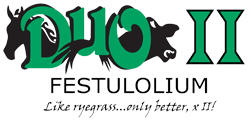Duo II Festulolium
High yields
Excellent palatability
High feed value
Excellent persistence
Description
Duo II Festulolium is like ryegrass, but better! It combines the quick establishment, high feed value, production, and palatability of perennial tetraploid ryegrass with the extra persistence and summer productivity of meadow fescue. Duo II has a high sugar content that is easily digestible, allowing animals to gain a high-energy ratio for milk/meat conversion.
Duo II's meadow fescue parentage provides improved persistence without quality loss. As a true perennial, Duo II is genetically designed for multiple years of production. Initial trial results show Duo II outperforming many other varieties in yield trials. Meadow fescue parentage minimizes "summer slump," while ryegrass parentage maximizes spring and fall growth.
Duo II is preferred over many other species because its long, tender leaves are "sweet" like ryegrass. Duo II provides high yields for many years. Dairy farmers should expect milk production results similar to tetraploid ryegrass.
Other Info
Applications:
Duo II is recommended for hay, grazing, silage or green chop (direct feeding). When mixed with alfalfa or clovers, Duo II provides a long lasting grass companion that will enhance the quality of the
cow's diet. When seeded alone or with other grasses, Duo II provides excellent season long forage.
Seeding Rates/Management Tips:
Plant Duo II at 25-30 lbs per acre or 15-20 lbs mixed with other grasses and legumes. If seeding Duo II with alfalfa in a new seeding (where alfalfa is predominant) plant no more than 3 lbs per acre.
Plant at 1/4" deep. Duo II can also be frost seeded. Duo II responds well to nitrogen, like its ryegrass parentage. Before planting your pasture, test your soil to add lime and fertilizer as needed.
Typically 150 lbs of N. per year is adequate. Apply 1/3 in the spring and then evenly after each harvest.
Grazing/Harvesting Tips:
When grazing, graze Duo II down to about 3-4" after the plant reaches 10-12" in height. This will provide the maximum forage quality and leaf-to-stem ratio. When cutting for hay, leave 3-4 inches
to allow the Duo II plants to tiller out. Tillering out is the plant's natural survival mechanism and allows the plants to be more persistent. As with any forage, management practices dictate the
quality of the forage nearly as much as the genetics of the product. With proper management, Duo II should provide high yielding, high quality forage resulting in maximum profitability for farmers.
Be sure to visit our Festulolium Facts page also.
